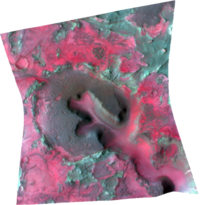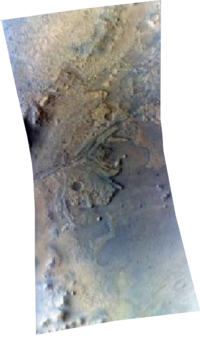The Compact Reconnaissance Imaging Spectrometer for Mars (CRISM) is a Visible and Near-Infrared (VNIR) imaging spectrometer onboard Mars Reconnaissance Orbiter (MRO), in orbit since 2006. It was built and tested by the Johns Hopkins University Applied Physics Laboratory under the supervision of principal investigator Scott Murchie. The observations enable to have mineralogy information of the martian surface at a spatial resolution of ~20 to ~200 m/px.
Data description
he CRISM instrument has two acquisition modes:
1. The targeted mode (multiangular pointing)
The instrument tracks the targets and takes 11 hyperspectral images (544 bands from 362 to 3920 nm) at different emission angles due to the rotation of the detector at ± 70°: 10 hyperspectral images taken at different emission angles before and after the central image corresponding to the close nadir image (image #07). The 10 hyperspectral multi-angular observations are reduced to a factor 10 compared to the spatial resolution of the central image. According to the spatial resolution of the central image, four product types are associated to this acquisition mode. If the central image is sampled at 20 m/px, the associated product is a Full Resolution Targeted observation (FRT). By reducing the spatial resolution of the central image by a factor 2, the spatial resolution is set at 40 m/px and the associated products are Half Resolution Short (HRS) and Half Resolution Long (HRL) observations. An HRL sampled surface is twice as long as an HRS observation. Only the central image #07 is processed by MarsSI for the mineralogy identification.
 |  |  |  | ||||||||||||||||||||||||||||||||||||||||||||||||||||||||||||
| FRT: 18 m/px | HRS: 36 m/px | HRL: 36 m/px | ATO: 3-12 m/px |
